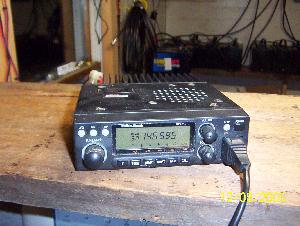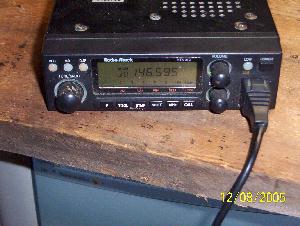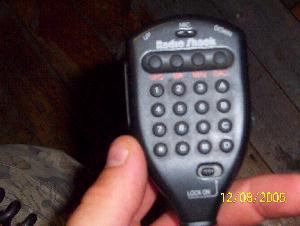

*Operating A 2-Meter Ham Radio*
First and foremost, it is ILLEGAL by federal law to transmit (talk) on any amateur frequency with out the proper license (unless a licensed control operator is present). The only time it is permitted is during a real emergency. You (unlicensed) borrow your friendís truck and he is a ham operator. You run out of gas, this does not justify you using his ham radio. This is not a real emergency. Now, if you are in your ham friendís truck and you happen to see a house on fire or a motor vehicle accident with serious injuries etc etc, now you are justified in using the radio to try and summons help.
Using it is no problem. So what if you donít have a call sign, you can still get help. You will need a slight knowledge of a ham radio and how it works. Knowing some frequencies would come in handy too.
The NATION WIDE 2-meter calling frequency is simplex 146.520 MHz (megahertz). Many hams monitor or scan this frequency. In some states, the state police also monitor this frequencyÖ.which I think is an excellent idea. I have seen signs on I-95 in Massachusetts saying "State Police 146.52". That would be a good frequency to start on.
Iíll be upfront. If the radio isnít programmed and you canít get anybody on 146.520, youíre probably hosed. Even if you start tuning through frequencies and hear somebody, that doesnít mean you can talk to them. They might be on a repeater which requires a frequency shift and possibly a PL tone to allow access. You canít just pick up a ham radio w/o having an idea of how everything works and start programming it.
Ok, letís define some things-
Simplex- Simplex means that you transmit AND receive on the SAME frequency. You talk from radio to radio, no repeaters involved. Simplex is just like using a CB radio.
Ĺ Duplex- A typical repeater. Half duplex means that you transmit and receive on 2 DIFFERENT frequencies. Letís say that you look at a 2-meter repeater listing and see "145.430 - " That - sign means that there is a minus offset (frequency shift). In 2-meters that will be .600 MHz. (notice the period before the 600) That is the typical frequency shift. Some repeaters might be different, if so, they should be listed with either the input frequency or the shift. 145.430 minus .600 equals 144.830. That means you need to program your radio to listen on 145.430 and transmit on 144.830. With the half duplex, you are talking on one frequency, while the repeater listens to YOU and simultaneously retransmits YOUR signal on another frequency. Whomever you are talking to listens to your signal after it goes through the repeater. (If youíre still confused, hopefully itíll clear up in a little bit).
Repeater- A repeater can be thought of as a "tower" on a mountain. It greatly extends the range of handheld, mobile and base stations. A repeater listens to your signal while at the same time re-transmitting it for somebody else to hear. What makes repeaters tick?
Ok, the odds are your friendís radio already has simplex and repeater frequencies programmed in to it. If it has a button that says "CALL", try pushing it. Most likely itíll take you directly to 146.520. If not, press it again and itíll pop back to the previous frequency.


Iím going to describe how to use a Radio Shack HTX-212. It is a simple straight forward radio w/o all the bells, whistles and fancy stuff.
Here are some common buttons and knobs youíll see on about any radio.
PWR=power
VOL= volume
SQL=squelch (turn this counterclockwise and then clockwise just beyond the point of where the static stops)
M-CH/TUNE= Memory channel or tune knob. This will select the frequency in the VFO mode or memory channel in the memory mode.
Low/High= Switches the transmitter between low and high power
VFO button= variable frequency oscillator. This is where frequencies are manually selected.
MEM/MR= puts the radio in to memory mode.
Those are the only things you should have to play with.
Ok, so your friendís radio is programmed. The scenario isÖyou have borrowed your friendís truck and you come across a head on collision. There are some other people there trying to call 911 on cell phones, but there is no phone service. You get out and find that there are 4 people injured. EMS is needed NOW! You go back to the truck and turn on the radio. Odds are, itíll power up and display a frequency your friend uses often. Many areas use a "local" simplex or repeater frequency. I recommend trying this first. On the HTX-212 the power level is to the right of the frequency. If it says HIGH, youíre good to go. If it says LOW, push the button between the volume knob and power button, then it will say HIGH.

Pick up the mike and push the PTT (push to talk) button. Itís typically located on the side.
Say "MAYDAY, MAYDAY, MAYDAY, this is (insert your name). I am at a car accident and I need help." Then release the PTT and wait a few moments for a response. Try it a couple of times and if no response try 146.520. Say the same thing. If thereís no response there, try some more of the frequencies in the memories. If you find one that has a + or - sign displayed with it, this means that itís a repeater frequency.
Ok, once somebody answers you be ready to at least provide them with-
What happened
Where the scene is
How many are injured
Of course the more info you can give the better. Is a vehicle upside down? Has anyone been ejected? Are there kids involved? Is there entrapment? Etc etc.
Once you have given the information donít abandon the radio. If youíre going to leave the truck, crank up the volume so you can hear if somebody is trying to get back in touch with you.
NOBODY should ever chastise you for using a ham radio in a true emergency.
Jaden
www.alpharubicon.com
All materials at this site not otherwise credited are Copyright © 1996 - 2005 Trip Williams. All rights reserved. May be reproduced for personal use only. Use of any material contained herein is subject to stated terms or written permission.